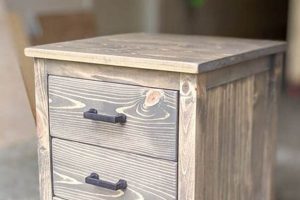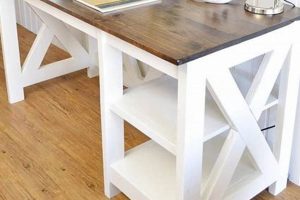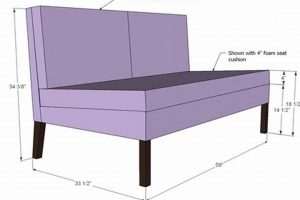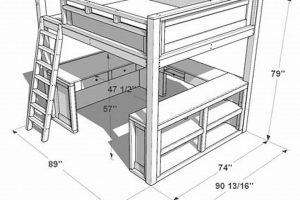Instructions for constructing a custom bathroom sink cabinet are readily available resources that guide individuals through the process of building their own vanity. These resources provide detailed steps, material lists, and often include diagrams or illustrations to aid in the construction of a personalized bathroom fixture. For example, one might utilize a set of documents outlining the assembly of a wall-mounted cabinet with specific dimensions to fit a particular sink and bathroom layout.
Creating personalized bathroom furnishings offers several advantages, including cost savings, customization to specific spatial requirements, and the satisfaction of crafting a functional and aesthetically pleasing element for the home. Historically, constructing furniture was a common practice, enabling individuals to adapt pieces to their unique needs and preferences, a tradition that continues with contemporary interest in handcrafted items and home improvement projects. The rise in popularity of these projects reflects a desire for individuality and a focus on resourcefulness.
The subsequent discussion will delve into various aspects of constructing a bathroom sink cabinet, including selecting appropriate materials, understanding essential tools and techniques, and addressing common challenges encountered during the building process. This exploration will equip readers with a foundational understanding of the steps involved in creating a functional and visually appealing bathroom fixture.
Essential Guidance for Bathroom Cabinet Construction
The following recommendations are intended to provide practical advice for individuals undertaking the construction of a custom bathroom sink cabinet. Adherence to these guidelines will contribute to a successful outcome.
Tip 1: Material Selection: Prioritize moisture-resistant materials such as marine-grade plywood or hardwoods like oak or maple treated with sealant. This precaution is crucial for mitigating water damage in the humid bathroom environment.
Tip 2: Accurate Measurements: Meticulously measure the available space and the dimensions of the sink. Precise measurements prevent costly errors and ensure a proper fit.
Tip 3: Secure Fasteners: Utilize high-quality screws and wood glue designed for woodworking. Insufficiently secured joints can compromise the structural integrity of the cabinet.
Tip 4: Level Installation: Ensure the cabinet is perfectly level during installation. An unlevel installation can lead to instability and functional issues with the sink.
Tip 5: Adequate Ventilation: Incorporate ventilation within the cabinet to prevent moisture buildup and mildew growth. This can be achieved through small vents or strategically placed openings.
Tip 6: Consider Plumbing Access: Plan for easy access to plumbing connections for maintenance and repairs. Integrating removable panels or strategically placed openings can simplify future plumbing work.
Tip 7: Prioritize Safety: Employ appropriate safety equipment, including safety glasses and hearing protection, when operating power tools. A safe working environment minimizes the risk of injury.
By incorporating these directives, individuals can enhance the durability, functionality, and aesthetic appeal of their custom-built bathroom sink cabinet. Careful planning and attention to detail are paramount for a successful outcome.
The subsequent section will address common design considerations and stylistic choices relevant to the construction of a bathroom fixture, providing further insight into creating a personalized and functional space.
1. Precise measurements
The accuracy of dimensions is paramount in the context of constructing a bathroom sink cabinet. Dimensional fidelity directly impacts the fit, function, and structural integrity of the final piece. Deviations from intended measurements can lead to significant complications and necessitate corrective actions, potentially increasing material waste and labor costs.
- Spatial Accommodation
Ensuring the constructed cabinet fits within the intended bathroom space requires accurate measurements of the available area. This includes accounting for existing plumbing fixtures, wall obstructions, and door clearances. Failure to accurately assess spatial constraints can result in a cabinet that cannot be installed or that impedes the use of the bathroom.
- Sink Integration
The dimensions of the chosen sink directly influence the cabinet’s design. The cabinet must accommodate the sink’s bowl, faucet, and drain assembly. Inaccurate measurements can lead to a sink that does not properly fit within the cabinet, resulting in instability, leaks, or an unusable configuration.
- Component Interoperability
Individual components, such as drawers, doors, and shelves, must be precisely measured to ensure proper function and alignment. Inaccuracies in these measurements can result in drawers that stick, doors that do not close correctly, or shelves that are unstable. These issues detract from both the aesthetic appeal and the functionality of the finished product.
- Structural Integrity
Precise measurements are critical for maintaining structural integrity. Misaligned or improperly sized components can compromise the cabinet’s stability and load-bearing capacity. Ensuring accurate dimensions for frame members and support structures is essential for creating a durable and long-lasting piece of furniture.
In summary, the success of a custom-built bathroom sink cabinet hinges on the precision of measurements taken throughout the planning and construction phases. These measurements influence every aspect of the project, from initial spatial assessment to final component assembly. Addressing this aspect with due diligence is crucial for achieving a functional, aesthetically pleasing, and structurally sound result.
2. Material selection
The selection of appropriate materials exerts a decisive influence on the success and longevity of bathroom sink cabinet construction projects. The inherent moisture-rich environment of a bathroom presents a unique set of challenges. Therefore, the chosen materials must possess inherent resistance to water damage, warping, and degradation, or be treated to provide such protection. The correlation between material choice and project outcome is direct: unsuitable materials will invariably lead to premature failure, increased maintenance, and compromised aesthetics. For instance, utilizing standard particleboard without proper sealing will result in swelling and disintegration upon exposure to even minimal moisture.
Conversely, the implementation of appropriate materials directly contributes to the functional lifespan and visual appeal of the cabinet. Solid hardwoods, such as maple or oak, exhibit natural resistance to moisture and can be further enhanced with protective coatings. Marine-grade plywood offers exceptional resistance to delamination and warping due to its specialized construction and adhesive properties. Careful consideration of these factors during the initial planning phase mitigates the risk of future complications and ensures a durable and aesthetically pleasing outcome. The investment in quality, moisture-resistant materials represents a proactive measure against the deleterious effects of the bathroom environment.
In conclusion, material selection constitutes a critical juncture in bathroom sink cabinet construction. Ignoring the specific demands imposed by the bathroom environment introduces significant vulnerabilities. Prioritizing moisture resistance through the implementation of appropriate materials, such as treated hardwoods or marine-grade plywood, is indispensable for achieving a durable, functional, and aesthetically pleasing result. The understanding of this correlation is paramount for anyone undertaking the construction of a custom bathroom sink cabinet.
3. Joint construction
The successful realization of self-executed bathroom sink cabinet projects hinges critically on the application of sound joint construction techniques. The structural integrity and longevity of the cabinet directly correlate to the quality of the joints used to assemble its components. Inadequate joint construction leads to instability, premature failure, and a compromised aesthetic appearance. Consider a scenario where simple butt joints, relying solely on fasteners, are used to join the cabinet’s frame. The lack of inherent strength in this joint type would render the cabinet susceptible to racking and eventual collapse under normal use. Conversely, incorporating stronger joinery methods, such as mortise and tenon or dovetail joints, provides significantly enhanced structural support and resistance to stress, thereby prolonging the cabinet’s lifespan.
Beyond structural considerations, the choice of joint construction impacts the overall aesthetic of the finished piece. The visible nature of certain joints, such as dovetails, can contribute to the cabinet’s visual appeal, adding a touch of craftsmanship and sophistication. In practical applications, employing robust jointing techniques not only ensures structural stability but also minimizes the need for frequent repairs and adjustments. For instance, using pocket-hole joinery, while relatively simple, provides sufficient strength for many cabinet components when combined with adhesives and proper fastener selection. This method allows for concealed fasteners, resulting in a cleaner, more professional appearance. In scenarios demanding greater strength, such as supporting a heavy countertop, the use of mortise and tenon joints or reinforced rabbet joints becomes essential.
In summation, joint construction represents a fundamental aspect of bathroom sink cabinet creation. Proper joint construction dictates the overall durability, functionality, and aesthetic characteristics of the finished product. Recognizing the inherent strengths and weaknesses of various jointing methods, and applying them judiciously based on the specific demands of the project, is paramount for ensuring a successful and enduring outcome. The diligent application of appropriate joint construction techniques transforms a mere collection of materials into a functional and aesthetically pleasing element of the bathroom.
4. Plumbing access
Plumbing access constitutes a critical design consideration within self-executed bathroom sink cabinet projects. The degree of accessibility afforded to plumbing connections directly influences the ease of installation, maintenance, and potential future repairs. Inadequate allowance for plumbing access during the planning and construction phases can result in significant complications, necessitating costly and time-consuming modifications. For example, a vanity constructed without properly positioned access points might require partial disassembly to address a simple plumbing leak or replace a faucet. Conversely, a well-designed cabinet incorporates strategically placed openings or removable panels to facilitate unimpeded access to pipes, valves, and drain components.
Further considerations include the standardization of plumbing fixture dimensions and the potential for future upgrades or alterations. The chosen access points should accommodate a range of potential plumbing configurations, allowing for flexibility in fixture selection and simplifying future modifications. The integration of service loops within the plumbing lines, accessible through these access points, provides slack for adjustments without requiring the disconnection of pipes. In the context of older homes, where plumbing systems may deviate from current standards, meticulous planning for access becomes even more critical. The ability to easily inspect and maintain these systems reduces the risk of undetected leaks and consequential water damage.
In summary, plumbing access represents an indispensable component of bathroom sink cabinet design and execution. The incorporation of appropriately sized and strategically located access points streamlines installation, facilitates maintenance, and mitigates the potential for costly repairs. Prioritizing plumbing access throughout the design and construction process ensures the long-term functionality and maintainability of the custom-built bathroom fixture. A comprehensive understanding of plumbing system requirements and proactive planning for accessibility are essential for a successful outcome.
5. Finishing techniques
Finishing techniques represent a crucial stage in the realization of self-executed bathroom sink cabinet projects. These techniques, applied following the assembly of the cabinet, directly influence its aesthetic appeal, durability, and resistance to environmental factors prevalent in a bathroom setting. The selection and execution of appropriate finishing methods are integral to the success of any “diy bath vanity plans,” transforming a raw construction into a functional and visually cohesive element of the bathroom.
The primary objective of finishing techniques is to protect the underlying material from moisture, humidity, and potential damage from cleaning agents. Consider the application of a polyurethane coating to a wooden cabinet. This protective layer creates a barrier against water penetration, preventing swelling, warping, and the growth of mold or mildew. In contrast, neglecting to apply a suitable finish leaves the wood vulnerable to these detrimental effects, significantly reducing the cabinet’s lifespan. Beyond protection, finishing techniques also enhance the aesthetic qualities of the cabinet. Staining can accentuate the natural grain of the wood, while paint offers a broader range of color options to complement the bathroom’s overall design scheme. Proper sanding, priming, and multiple coats of finish contribute to a smooth, professional appearance.
In conclusion, finishing techniques are an indispensable element of “diy bath vanity plans.” They serve not only to protect the cabinet from the harsh bathroom environment but also to elevate its aesthetic appeal. The selection and skillful application of these techniques directly impact the longevity, functionality, and visual impact of the custom-built bathroom fixture. Thorough research and careful execution of finishing techniques are therefore essential for achieving a successful and satisfying outcome in bathroom sink cabinet construction.
6. Structural support
Structural support is a foundational element in the construction of a bathroom sink cabinet. Its significance stems from the cabinet’s need to bear the weight of the sink, countertop, plumbing fixtures, and stored items, while also withstanding the stresses of daily use. Inadequate structural support can lead to cabinet instability, sagging, or eventual collapse, rendering the unit unsafe and unusable. Therefore, the design and implementation of robust structural support mechanisms are paramount in any “diy bath vanity plans.”
- Frame Construction
The cabinet’s frame serves as the primary load-bearing element. Typically constructed from solid wood or plywood, the frame provides the skeletal structure to which other components are attached. Frame members must be adequately sized and securely joined to withstand the imposed weight. For instance, a frame built with thin, poorly joined members will likely fail under the weight of a heavy stone countertop.
- Leg and Base Reinforcement
Legs or a solid base provide vertical support for the cabinet. These elements must be designed to distribute the weight evenly across the floor. Reinforcement techniques, such as adding internal bracing or using thicker materials, enhance the load-bearing capacity. A vanity with inadequately reinforced legs may wobble or buckle over time.
- Internal Bracing and Support
Internal bracing, often in the form of stretchers or corner blocks, reinforces the frame and prevents racking or twisting. These elements distribute stress and enhance the overall stability of the cabinet. For example, stretchers positioned along the back of the cabinet prevent it from leaning away from the wall.
- Countertop Support
The countertop requires dedicated support to prevent sagging or cracking, particularly if constructed from heavy materials like granite or concrete. Support can be provided by adding additional framing members beneath the countertop or by using a full plywood subtop. Insufficient countertop support can result in costly damage to the countertop and the cabinet itself.
The successful integration of these structural support elements is critical for the durability and functionality of a bathroom sink cabinet. Proper planning and execution of these aspects ensure that the “diy bath vanity plans” result in a stable, safe, and long-lasting fixture capable of withstanding the demands of a bathroom environment. Neglecting these considerations can lead to premature failure and costly repairs, underscoring the importance of prioritizing structural integrity in any cabinet construction project.
7. Hardware choices
Hardware selection wields significant influence on the functionality, aesthetics, and longevity of “diy bath vanity plans.” These components, including hinges, drawer slides, knobs, and pulls, are not merely decorative; they directly impact the usability and overall quality of the finished product. Inappropriate hardware choices can compromise functionality, leading to issues such as drawers that fail to open smoothly or doors that do not align correctly. For example, the utilization of low-quality hinges on a heavy cabinet door may result in sagging or premature failure. Conversely, the selection of durable, well-engineered hardware enhances the cabinet’s performance and extends its lifespan. A cabinet constructed with high-quality, soft-close drawer slides will offer a superior user experience compared to one using inexpensive, basic slides.
Beyond functionality, hardware contributes significantly to the aesthetic character of the vanity. The style, finish, and material of knobs and pulls can complement or contrast with the cabinet’s overall design, adding visual interest and reinforcing the desired aesthetic. A modern vanity might feature sleek, minimalist hardware with a brushed nickel finish, while a more traditional vanity could incorporate ornate, antique-style hardware with a bronze or brass finish. In practical applications, carefully chosen hardware can elevate the perceived value of the cabinet and enhance the overall appeal of the bathroom. Moreover, considering factors such as ergonomics and accessibility when selecting hardware can improve the user experience, particularly for individuals with limited mobility or dexterity.
In summary, hardware choices are integral to the successful execution of “diy bath vanity plans.” These components affect not only the functionality and durability of the cabinet but also its aesthetic appeal and user-friendliness. Thoughtful selection of high-quality, appropriately styled hardware enhances the value and long-term satisfaction derived from the custom-built bathroom fixture. A thorough understanding of the relationship between hardware and cabinet design is essential for achieving a professional and functional result.
Frequently Asked Questions
The following section addresses common inquiries related to constructing a custom bathroom cabinet. These questions and answers are designed to provide clarity and guidance for individuals undertaking such a project.
Question 1: What is the estimated cost associated with building a custom bathroom sink cabinet?
The cost of constructing a personalized bathroom sink cabinet fluctuates significantly depending on the selected materials, the cabinet’s dimensions, and the complexity of the design. Basic projects, utilizing readily available lumber and straightforward construction techniques, may range from $100 to $300. Elaborate designs incorporating premium hardwoods, intricate joinery, and specialized hardware can easily exceed $1000.
Question 2: What essential tools are required for constructing a bathroom sink cabinet?
Essential tools include a circular saw or table saw for cutting lumber, a drill and driver for assembling components, a measuring tape for accurate dimensions, a level for ensuring proper alignment, and a sander for preparing surfaces for finishing. Additional tools, such as a router or a joiner, may be required for more advanced joinery techniques.
Question 3: Which type of wood is most suitable for bathroom sink cabinet construction?
Hardwoods such as oak, maple, and cherry offer durability and moisture resistance, making them well-suited for bathroom environments. Marine-grade plywood also presents a viable option due to its exceptional resistance to water damage and delamination. Softwoods, such as pine, can be used but require thorough sealing and finishing to prevent moisture absorption.
Question 4: How can I ensure adequate ventilation within the bathroom sink cabinet to prevent mold growth?
Ventilation can be achieved by incorporating strategically placed openings or vents within the cabinet structure. These openings allow air to circulate, preventing the buildup of moisture that can promote mold growth. Ensure that these vents are positioned in areas that do not compromise the cabinet’s structural integrity.
Question 5: What is the best method for sealing a bathroom sink cabinet to protect it from moisture?
A multi-layer approach is recommended. Begin with a high-quality primer to seal the wood, followed by multiple coats of a moisture-resistant paint or varnish. Ensure that all surfaces, including edges and corners, are thoroughly coated. Consider using a marine-grade sealant in areas prone to direct water exposure.
Question 6: How can I ensure that the plumbing connections are easily accessible for future maintenance?
Incorporate removable panels or strategically placed openings in the cabinet’s design. These access points should provide ample space to reach plumbing connections without requiring disassembly of the cabinet. Clearly mark the location of these access points for future reference.
The preceding questions and answers provide a foundational understanding of key considerations in constructing a custom bathroom sink cabinet. Adhering to these guidelines will contribute to a successful and enduring project.
The subsequent discussion will transition to resources available for “diy bath vanity plans” and guidance.
Conclusion
This exploration of “diy bath vanity plans” has illuminated the multifaceted considerations inherent in such a project. From material selection and precise measurements to joint construction and plumbing access, the success of a custom-built bathroom fixture hinges on meticulous planning and execution. The selection of appropriate hardware, coupled with effective finishing techniques and robust structural support, contributes to the overall functionality, longevity, and aesthetic appeal of the cabinet. Addressing these elements with due diligence increases the likelihood of a satisfactory outcome.
The creation of a custom bathroom sink cabinet represents a significant undertaking, demanding both technical skill and a commitment to detail. The information presented herein serves as a foundational guide for individuals embarking on this endeavor. Further research and careful consideration of project-specific requirements are strongly encouraged to ensure a successful and enduring result. The creation of a durable and visually appealing bathroom fixture, tailored to specific needs, remains a worthwhile pursuit for those willing to invest the necessary time and effort.







